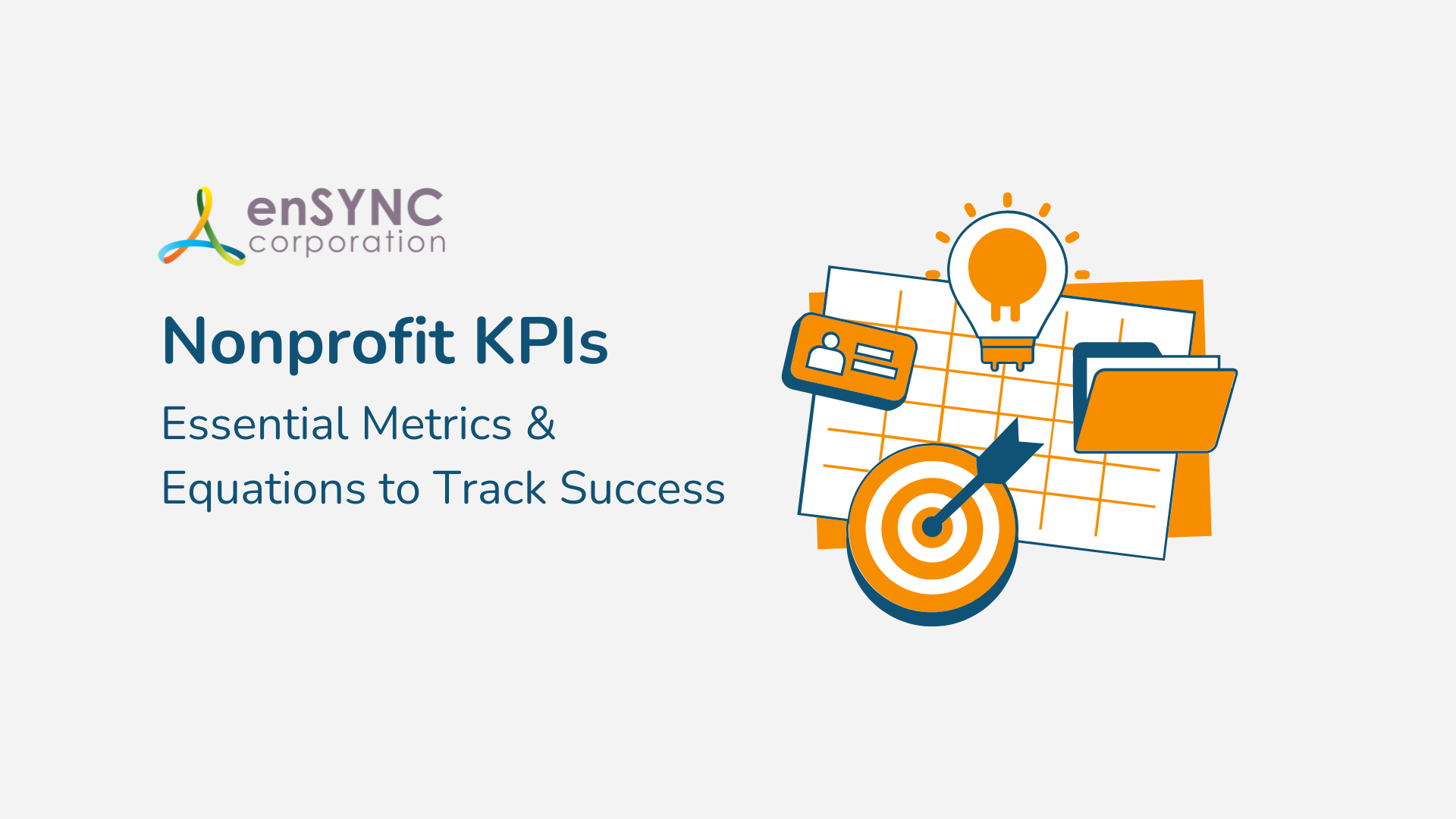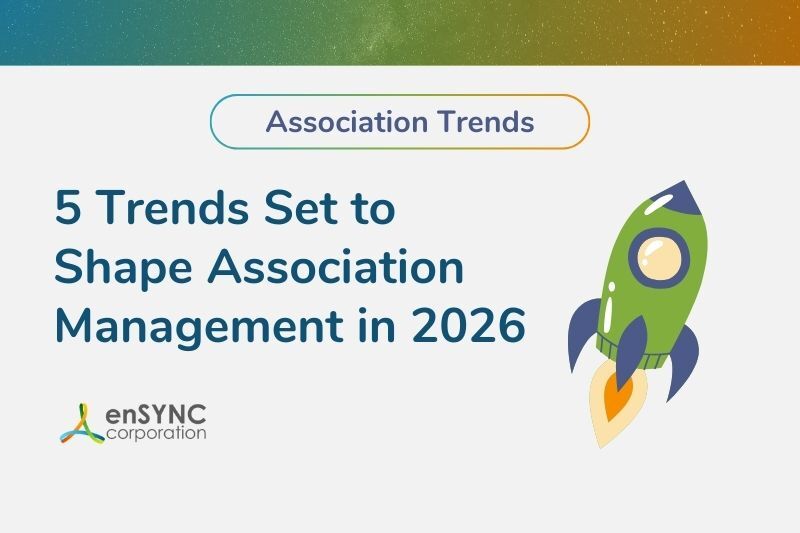Webinar | Strategy & planning | Nonprofits & associations | Financial management
14 KPIs and Financial Metrics for Nonprofits To Track
April 21, 2023
|
Nonprofit association leaders require accurate, relevant data to measure progress, gauge financial performance, and make informed decisions. That’s why tracking financial metrics and key performance indicators (KPIs) is critical to gaining insights that help maximize your organization’s mission and create financial sustainability. Read on to learn 14 important nonprofit metrics, how to calculate them, and why they are vital to your organization.
What is a key performance indicator (KPI) for Nonprofits?
A Key Performance Indicator (KPI) is a measurable metric used to assess the effectiveness of your nonprofit organization’s goals and objectives. KPIs can encompass a wide range of indicators, including financial, operational, qualitative, and quantitative metrics.
5 Steps to Choosing the Right KPIs for Your Nonprofit.
There are hundreds of financial KPIs, ratios, and financial metrics you can track. The key is finding the ones most relevant to your organization’s goals.
Here are some steps to get you started:
1. Remember your mission.
The first step is returning to your organization’s mission and identifying its primary goals. That way, you can identify specific points of focus and determine what metrics are most helpful in measuring progress in those areas.
2. Define strategic objectives.
Next, identify strategic objectives and determine which KPIs best measure progress toward their achievement. For example, if an objective is to raise money for a specific program, a useful KPI could be the donor growth rate.
3. Identify stakeholder expectations.
Donors, board members, and other stakeholders typically have different focus areas within the organization. Therefore, include KPIs in your financial reporting that are best aligned with their interests and organizational responsibilities.
4. Identify and prioritize relevant KPIs.
Since there are hundreds of KPIs to choose from, narrow down and prioritize your list based on their relevance to your organization's goals and objectives.
5. Measure regularly and adjust as required.
Consistency is often more important than frequency when measuring KPIs. Create a plan for measuring metrics and maintain that schedule in order to accurately derive valuable insights over time. Also, remember to revisit your KPIs and adjust your plan as the organization evolves.
Now let’s go over some key performance indicator examples. We’ll cover some of the most common metrics used by nonprofits, and share how to calculate KPIs in each category.
Revenue-Related Metrics Financial Metrics
Since revenue is critical to funding operations, tracking revenue-related financial metrics is essential to gauge the financial health and stability of the organization.

Some revenue-related metrics to track include:
Total Revenue
Total revenue measures income received from all sources, including donations, government grants, membership fees, corporate sponsorships, and merchandise sales.
Revenue By Source
Revenue by source breaks down income to reveal where the highest sources of revenue come from. This can help the nonprofit allocate promotional resources to the source that provides the most value to the organization.
Revenue Growth Rate
The revenue growth rate (RGR) tracks the percentage increase or decrease in income over a specific time.
How to calculate revenue growth rate:
- Revenue Growth Rate = ((Revenue in Current Period - Revenue in Previous Period) / (Revenue in Previous Period)) x 100
- For example, if revenue was $1000 this month and $800 last month: RGR = ((1000-800)/800)x100 = 25%
Average Gift Size
The average gift size (AGS) measures the average amount of money donors give per donation.
How to calculate average gift size:
- Average Gift Size = Total Donations/# Donations
- For example, if a nonprofit received $1000 from 10 donors: AGS = $1000 / 10 = $100
Donor Retention Rate
The Donor Retention Rate (DRR) reveals the percentage of repeat donors over time.
How to calculate donor retention rate:
- Donor Retention Rate = (Number of Donors in Current Period / Total Number of Donors in Previous Period) x 100%
- For example, if a nonprofit has eight donors in this period and ten donors in the previous period: DRR = (8 / 10) x 100 = 0.8 x 100 = 80%
Cost-To-Raise-A-Dollar / Fundraising Efficiency Ratio
The Cost-To-Raise-A-Dollar (CRD) or Fundraising Efficiency Ratio metric measures how effectively money is raised by comparing costs with revenue. Calculating this metric for different income sources helps the organization determine the most cost-effective way to raise funds.
How to calculate fundraising efficiency ratio:
- Cost to Raise a Dollar = Fundraising Cost ÷ Money Received
- For example, if an organization raised $20,000 by holding a concert with a total cost of $10,000: CRD = $20,000 / $10,000 = $2
Cost-Per-Donor Acquisition
The Cost-Per-Donor Acquisition (CPDA) measures how much it costs to acquire a new donor.
How to calculate cost-per-donor acquisition:
- CPDA is calculated by summing all the costs of a fundraiser and dividing that figure by the total amount of donors.
- For example, if an organization held a fundraiser costing $10,000 and received 1000 unique donations:
CPDA = $10000 / 1000 = $10
Expense-Related Metrics
Tracking expenses is essential to ensure financial stability, demonstrate accountability, and prevent fraud.

Some expense-related metrics to measure in this category include:
Program Efficiency Ratio
The Program Efficiency Ratio (PER) measures the percentage of total expenses directly related to program activities. Higher percentages indicate that the organization is focusing on its mission, while lower percentages reveal that the overhead costs may be excessively high.
How to calculate program efficiency ratio:
- PER = Program Expenses / Total Expenses x 100
- For example, if an organization is spending $6,000 on programs and $8,000 on overhead in Q1, and $6,000 on programs and $10,000 on overhead in Q2:
PER - Q1 = 6000 / 8000 X 100 = 75%
PER - Q2 = 6000 / 10000 x 100 = 60% - The difference between quarters reveals that overhead spending is increasing compared to program spending, which impacts the organization’s mission.
Fundraising Expense Ratio
The Fundraising Expense Ratio (FER) measures how fundraising expenses compare to overall costs. Higher values indicate that more money is being spent to raise funds to support the organization’s mission.
How to calculate fundraising expense ratio:
- FER = Fundraising Expenses / Total Expenses x 100
- For example, if an organization is spending $14,000 on fundraising and $20,000 on total expenses in Q1, and $18,000 on programs and $20,000 on total costs in Q2:
FER - Q1 = 14000 / 20000 X 100 = 70%
FER - Q2 = 18000 / 20000 x 100 = 90% - The difference between quarters reveals that overhead fundraising expenses are increasing, possibly indicating that the organization is spending more on fundraising activities that help fulfill its mission.
Administrative Expense Ratio
The Administrative Expense Ratio (AER) measures the percentage of total expenses directly related to administrative activities. Lower percentages may indicate that the organization’s administrative costs are either under control or too low. Conversely, higher percentages may reveal that the nonprofit is not managing resources efficiently.
How to calculate admin expense ratio:
Similar to the FER, the AER is calculated by dividing administrative expenses by total expenses.
Expense-to-Revenue Ratio
The Expense-to-Revenue Ratio (ERR) measures the relationship between money flowing in and out of the organization.
How to calculate expense-to-revenue ratio:
- ERR = Operating Expenses / Total Revenue x 100
- For example, if an organization’s financial statements showed $8,000 in operating expenses and $10,000 in total revenue:
ERR = 8000 / 10000 X 100 = 80%
Liability-Related Metrics
Measuring liability-related KPIs is important to ensure resources are available to fund programs and maintain long-term financial health.

Some liability-related metrics nonprofits can track include:
Debt-To-Equity ratio
The Debt-To-Equity (D/E) ratio measures how much debt a nonprofit has compared to its assets. Measuring this metric over time indicates how well the organization is positioned over the long term with respect to its liabilities.
How to calculate debt-to-equity ratio:
D/E = (Short-Term Debt = Long-Term Debt + Fixed Payments) / Shareholder's Equity
For example, if the balance sheet shows total debt of $60,000 and total equity worth $120,000:
D/E = 60000 / 120000 = 0.50
This means the nonprofit has 50 cents of debt for every dollar in equity.
Current ratio
The current ratio (CR) measures how well an organization can pay off short-term debts.
How to calculate current ratio:
- CR = Current Assets / Current Liabilities
- For example, if a nonprofit’s statement of cash flows shows current assets (such as cash or accounts receivables) of $10,000 and current liabilities (such as credit card debt and accounts payable) of $5,000:
CR = 10000 / 5000 = 2 - This means the nonprofit has $2 available for every $1 of short-term debt. A current ratio of 2 or more is a standard benchmark.
Unrestricted Net Assets
The Unrestricted Net Assets (UNA) ratio measures the percentage of unrestricted net assets. This metric reveals the degree of flexibility the organization has regarding resource usage.
How to calculate unrestricted net assets:
The first step is deducting the organization's total liabilities from total assets to determine total net assets. From there, identify any restricted items from net assets and deduct that amount as follows:
- Unrestricted Net Assets = Total Net Assets - Restricted Net Assets
- For example, if an organization’s Total Net Assets are $10,000, but $5,000 of that is restricted to a specific fund:
UNA = 10000 - 5000 = $5,000
Other Important Metrics Nonprofits Should Track

As mentioned previously, there are hundreds of KPIs available to track your nonprofit’s performance.
Some additional metrics you can track include:
- Insurance Coverage Ratio
- Reliance Ratio
- Operating Reserves
- Time to Break Even On New Programs
- Board Turnover Rate
- Employee Turnover Rate
- Reserve Ratio
- Liquidity
- Donor Engagement
- Donor Lifetime Value
- Technology Adoption Rate
- Website Traffic
- Social Media Engagement
Choosing the right metrics depends on factors specific to your nonprofit’s mission. Depending on your fundraising management software, many metrics can be calculated and reported automatically.
How to Track Nonprofit KPIs – Nonprofit Dashboards, AI-Powered Reporting
Integrating these KPIs and calculations into your regular nonprofit performance tracking is crucial for the finance and accounting department. By doing so, you can efficiently monitor KPIs, centralize essential data, and empower teams to make data-informed decisions.
Leverage nonprofit dashboards within your existing technology and tools to streamline this process. Setting up a dedicated nonprofit metrics dashboard ensures that all critical KPIs for the finance and accounting department are tracked in one place, using real-time data for accurate reporting and strategic planning.
We’ve helped numerous clients implement nonprofit dashboards tailored to their needs. “Many of our nonprofit clients already track these KPIs, but they often lack a centralized system to automate the process and ensure data accuracy,” says Chadd Arthur, Vice President of enSYNC. “By integrating KPI tracking with real-time data, organizations gain better visibility, allowing teams to make informed decisions and optimize finances more effectively.”
The Future of Nonprofit KPI Reporting
The way nonprofits track KPIs is evolving alongside the growing adoption of artificial intelligence (AI) tools for reporting and analytics. According to an article from The Nonprofit Times, nonprofit use of AI is outpacing business in the private sector with 58% of nonprofits using AI compared to 47% in B2C.
“Nonprofit software like iMIS, Sage Intacct, and others have already integrated AI-driven tools to automate reporting and KPI tracking,” says Chadd Arthur, Vice President of enSYNC. “These advancements allow nonprofit teams to streamline workflows and gradually adapt to AI, making KPI tracking more efficient and insightful.”
Learn how to leverage the power of metrics to maximize your nonprofit’s impact.
Your organization generates a treasure trove of data that can be used to enhance fundraising efforts, optimize operations, and improve services.
enSYNC helps you capture and unlock the power of that information with software solutions customized for nonprofit organizations.

Warren Duncan brings impressive experience in financial planning, budgeting, forecasting, analysis, and reporting to the team. His expertise has proven invaluable in contributing to enSYNC's financial success and strategic decision-making. He also regularly helps clients with Sage Intacct reporting and part-time accounting duties. Warren's educational background includes studies at Southeastern Louisiana University, Baton Rouge Community College, and Slidell Theological Seminary. This diverse educational foundation reflects his commitment to continuous learning and a well-rounded approach to his professional endeavors. Beyond his role at enSYNC, Warren serves as a pastor of a church in Illinois, showcasing his multifaceted talents and commitment to community engagement. This unique aspect of his life speaks to his dedication not only to his professional responsibilities but also to his role as a spiritual leader, demonstrating a holistic approach to personal and professional growth. As Warren continues to contribute to enSYNC's financial success, his diverse background and commitment to continuous improvement make him a dynamic and well-rounded resource. His unique blend of financial acumen, educational achievements, and community leadership positions him as a valuable asset to enSYNC and the broader community he serves.
Recent Posts

5 Trends Set to Shape Association Management in 2026
As 2026 begins, associations are standing at the edge of some major shifts. Member expectations are changing, technology keeps opening new...

The Best of the Blog 2025 — A Year in Review
From forward-looking trend analyses to powerful case studies and thought-provoking conversations, the enSYNC blog featured a host of great content in...
Enjoying our blog?
At enSYNC, we want to empower associations and nonprofits to make well-educated decisions. If you want our industry knowledge (and other free guides) sent directly to your inbox, fill out the form below.



